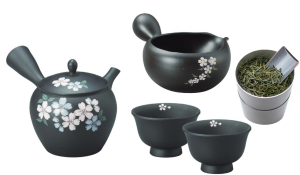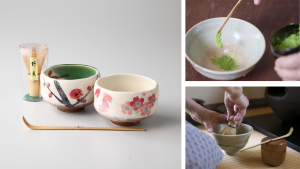News
2025.04.21
Columns
Japanese Tea Culture and Tea Utensils

Tea is a very familiar part of Japanese life. Many people make tea at home every day, bring it to school or work in a water bottle, or drink tea with meals. The diverse ways of drinking and enjoying tea go beyond simply being a means of hydration; they are closely linked to culture, tradition, and the spirit of hospitality. In this column, we explore how tea, which is familiar on a daily basis, is integrated into the lives of Japanese people and how it can be enjoyed on special occasions. We will also introduce a wide range of tools that enhance the flavor of Japanese tea and how to brew matcha. Why not take a peek into the depths of Japanese tea culture?
Table of Contents
1. Three Situations in which Tea is Drunk in Japan
_1.1. As a Daily Source of Hydration
_1.2. As a Source of Enjoyment
_1.3. As a Way to Entertain Guests
2. Easy Ways to Enjoy Tea Using Tea Utensils
_2.1. Enjoying Green Tea and Roasted Green Tea
_2.2. Enjoying Matcha
3. Summary
Three Situations in which Tea is Drunk in Japan
Here are three typical situations in which people drink tea in Japan.
As a Daily Source of Hydration
In Japan, tea is an essential way to stay hydrated on a daily basis. Tea is drunk at various times, such as when you are thirsty or during meals. Many households probably keep prepared tea in the refrigerator. Typical teas drunk at home include green tea, roasted green tea (hoji-cha), and barley tea, but oolong tea, jasmine tea, black bean tea, corn tea, and mate tea are also popular. It is common to make tea by boiling in a kettle or by brewing in water, but more and more households are stocking up on bottled tea. Convenience stores and supermarkets sell a wide variety of teas at reasonable prices, so you can enjoy them anytime.
By the way, when I drank tea overseas, I was very surprised to find that it was sweet with sugar. In Japan, tea is rarely added with sugar, except for black tea. Some Japanese people would be surprised if sweet green tea was sold in Japan. On the other hand, sweet tea is more common overseas, and people who come to Japan are sometimes surprised by “unsweetened tea”.
As a Source of Enjoyment
Black tea and matcha are drunk more for pleasure than as a daily hydration. Although these are “tea,” they are slightly distinguished as “black tea” and “matcha.”
Black tea is often drunk at specific times, such as breakfast or tea time, and many of the bottled teas sold are sweet with sugar, similar to the way tea is drunk overseas.
Matcha is enjoyed in even more limited situations. Only a minority of people make and drink matcha at home on a daily basis, and it is generally drunk at Japanese cafes and tea ceremony events. It is not uncommon for schools to have a tea ceremony club as part of their school activities. As such, matcha may seem a little difficult to make, but matcha-flavored sweets and matcha lattes are popular among young people and are enjoyed in a more familiar way.
As a Way to Entertain Guests
In Japan, there is a hospitality culture of serving tea when guests visit your home or workplace. When staying at an inn, you may be offered tea and sweets when you arrive in your room. For hospitality tea, freshly brewed hot green tea is often used, but cold green tea may also be served during the hot summer months. This relationship between hospitality and tea is said to have its origins in the Wabicha tea ceremony of the Muromachi period (around 14 -16 century).
Easy Ways to Enjoy Tea Using Tea Utensils
The choice of utensils is important to enjoy tea. The utensils used and the way of drinking green tea and roasted green tea are completely different from those of matcha. Here, we will introduce how to make tea that is easy and delicious.
Enjoying Green Tea and Roasted Green Tea
A kyusu teapot is an essential tool for enjoying green tea and roasted green tea. A kyusu teapot brings out the best flavor of the tea leaves. You can easily make tea by just pouring hot water into a tea bag, but tea brewed using a kyusu teapot is exceptional.
■Tools to Prepare

・”Kyusu” Teapot
・Tea leaves (your favorite, such as gyokuro, sencha, bancha, roasted green tea, etc.)
・”Yunomi” Teacup
・”Yuzamashi” Water cooler (if you don’t have one, you can use a teacup or a regular cup instead)
■How to Brew Green Tea and Roasted Green Tea
1. Adjust the temperature of the water
The ideal water temperature varies depending on the type of tea. For roasted green tea, boiling water at 100℃ is the appropriate temperature, for bancha, around 80℃, for sencha, 70-80℃, and for gyokuro, 50-60℃. For teas other than roasted green tea, avoid boiling water to reduce bitterness and bring out a mellow flavor. You can lower the temperature of the water by about 10℃ by using a yuzamashi or pouring hot water into a teacup.
2. Put the tea leaves into the teapot.
One teaspoon (about 2-3g) of tea leaves is the standard for one serving.
3. Pour the hot water.
Gently pour the hot water into the teapot and enjoy the aroma as the tea leaves open up.
4. Observe the extraction time.
The standard is about 30 seconds to 1 minute for green tea and about 1 minute for roasted tea. Be careful not to let it steep for too long, as it will become bitter.
5. Pour into the teacup.
Gently shake the teapot to mix the tea leaves evenly, then slowly pour into the teacup. If pouring into multiple teacups, pour in a circular motion to ensure the tea is of a uniform strength.
Using a teapot is more time-consuming, but it deepens the flavor of the tea. Why not enjoy Japanese tea to your heart’s content? Please see this Goods & Cases page for teapots sold by Imoto Sangyo.
Enjoying Matcha
Matcha is drunk in a completely different way than green tea. The condition of the tea leaves is also different, and special tools are used. Here, we will introduce how to drink matcha at home to easily enjoy it.
■Tools to prepare

・Matcha bowl
・Tea whisk
・Tea scoop
・Matcha powder
・Hot water (about 70-80℃)
■How to make matcha
1. Adjust the amount of matcha
Scoop up the matcha with the tea scoop and put it in a matcha bowl. Usually, two tea scoops (about 2g) is the appropriate amount.
2. Pour hot water
Pour 70-80℃ hot water into the matcha bowl. The amount should be about 50-70ml.
3. Whisk with the tea whisk
Use the tea whisk to stir by moving it quickly in an “M” shape. You can adjust the amount of foam to your liking.
4. Drinking
Hold the matcha bowl with both hands and drink slowly, enjoying the rich flavor and aroma. Also, by combining it with Japanese sweets, the bitterness and sweetness of matcha are exquisitely harmonious.
In the tea ceremony, different matcha bowls are used according to the season. When enjoying it at home, you can enjoy the four seasons of Japan by collecting matcha bowls for each season, and it is also nice to find a favorite one and use it for a long time. Please see the Goods & Cases page for teapots handled by Imoto Sangyo.
Summary
Japanese tea culture plays an important role in refreshing daily life and coloring special moments. Tea is close to people’s hearts in different ways, as a way to hydrate the throat, as a pleasure, and in hospitality situations. Furthermore, by adding ingenuity to the selection of utensils and brewing methods, you can get a richer taste and experience. In this way, tradition and modernity are fused in Japanese tea culture, and there are many ways to enjoy it. Why not try to find small happiness through tea in your daily life?
If you are interested in handling teapots, matcha bowls, etc., please take a look at our trading “Cases” page. If you would like to check the details of our products, please contact us via the “Contact” page.
Category
Archive

